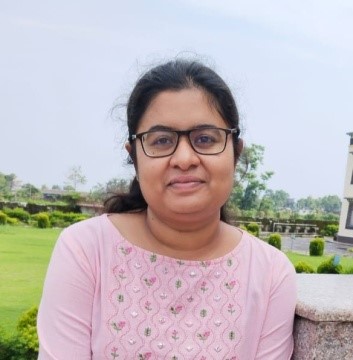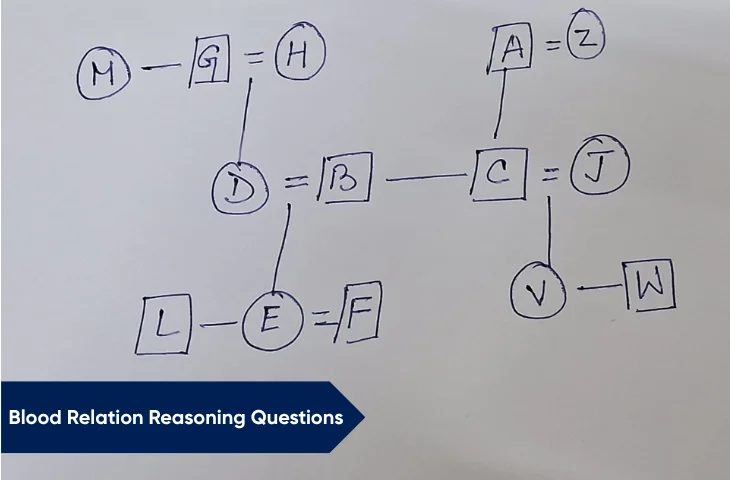Blood relation questions is an interesting and scoring topic in Reasoning. Questions from this section are generally easy to solve and can help you secure full marks in less time. In this blog, we have covered all the essential details related to the Blood Relations topic in Reasoning, including formulas, equations, examples, and more.
What are Blood Relation Reasoning Questions?
Blood relation questions test your understanding of family relationships. These can be direct (e.g., brother, sister) or indirect (e.g., brother-in-law, maternal uncle), and usually require you to analyze statements and map relationships logically.
Why Blood Relation Questions Are Important for Exams?
Questions from the blood relation topic are frequently asked in all major exams such as IBPS PO, IBPS Clerk, SBI PO, SSC CGL, SSC CHSL, and more.
- SSC CGL, CHSL, MTS
- IBPS PO, Clerk, SBI PO
- RRB NTPC, ALP, Group D
- State PSCs, Police Constable Exams
Most exams include 1–2 questions, and it’s considered a scoring topic when approached with a proper method.
What Is the Exam-Wise Expected Questions in Blood Relation Reasoning?
Mostly, 1 to 2 questions from the Blood Relation topic are asked. Further details about the exact number of questions in recent exams are given below:
| Exam | Number of Questions | Difficulty Level |
| SSC CGL/CHSL | 1–2 | Easy |
| IBPS PO/Clerk | 2-3 | Moderate |
| RRB NTPC | 1 | Easy |
| State PSC | 1–2 | Varies |
Most questions are verbal, though some exams ask diagram-based puzzles as well.
What Are the Core Concepts in Blood Relation Reasoning?
The core concepts of the Blood Relation topic are as follows:
| Concept | Explanation |
| Direct Relations | Straightforward, like brother, mother, daughter |
| Indirect Relations | Involve multiple steps or generations |
| Gender Clues | Look for clues in pronouns like “he”, “she”, “his” |
| Reverse Mapping | Always start from the person being asked about |
| Diagram Drawing | Family tree method helps avoid confusion |
| No Assumptions | Never assume gender or relationship without clear mention |
How to Solve Blood Relation Questions Faster?
There are a few effective tricks to solve Blood Relation questions. Details of these tricks are as follows:
Use Family Tree Diagrams
Draw quick diagrams to map relationships. Keep males on one side and females on another, and connect with lines to show relationships.
Start from the Question, Not the Statement
If the question asks, “How is A related to B?”, start from B and trace toward A using the information in the statements.
Look for Keywords
Words like “only son”, “daughter of my father’s sister”, or “wife of my husband’s brother” carry strong clues identify them first.
What are the types of Blood Relation Questions Asked?
There are 8 types of questions that are asked from the topic of Blood Relation. The details of these types of questions are as follows:
- Direct Relationship
- Questions give a simple relationship and ask about a specific person.
- Example: “A is the father of B. B is the mother of C. How is A related to C?”
- Coded Relationship
- Relationships are represented using symbols or coded words.
- Example: “If ‘A × B’ means ‘A is the father of B’, then what does ‘X × Y’ mean?”
- Complex / Puzzle Relationships
- Multiple generations or mixed relationships, requiring stepwise deduction.
- Example: “P is the father of Q. Q is the brother of R. R is married to S. How is P related to S?”
- Gender-Based Relationships
- Questions pay attention to gender pronouns like son, daughter, father, mother.
- Example: “A is the mother of B. B is the brother of C. How is C related to A?”
- Mixed / Trick Relationships
- Relationships described indirectly using cousins, uncles, nephews, etc.
- Example: “X is the brother of Y. Y is the father of Z. How is X related to Z?”
- Symbolic / Word Problems
- Relationships are represented using symbols like @, #, $, etc.
- Example: “‘@’ means mother, ‘#’ means father. If A @ B # C, how is A related to C?”
- Generational Relationships
- Involves grandparents, grandchildren, cousins, etc.
- Example: “M is the son of N. N is the father of O. How is M related to O?”
- Family Tree / Diagram Questions
- A description is given and you are asked to draw a family tree to answer.
- Example: “P is married to Q. P has two sons, R and S. R has one daughter T. How is T related to Q?”
Various Types of Blood Relation Questions with Solution
Different types of blood relation questions with solutions are as follows:
1. Direct Relationship
Example:
“A is the father of B. B is the mother of C. How is A related to C?”
Solution:
- Step 1: A → Father of B
- Step 2: B → Mother of C
- Step 3: Therefore, A is the grandfather of C.
Answer: Grandfather
2. Coded Relationship
Example:
“If ‘A × B’ means ‘A is the father of B’ and ‘A + B’ means ‘A is the mother of B’, then what does ‘P × Q + R’ mean?”
Solution:
- Step 1: P × Q → P is father of Q
- Step 2: Q + R → Q is mother of R
- Step 3: Therefore, P is the grandfather of R.
Answer: Grandfather
3. Complex / Puzzle Relationship
Example:
“P is the father of Q. Q is the brother of R. R is married to S. How is P related to S?”
Solution:
- Step 1: Q and R are siblings → P is the father of both Q and R
- Step 2: R is married to S → P is father-in-law of S
Answer: Father-in-law
4. Gender-Based Relationships
Example:
“A is the mother of B. B is the brother of C. How is C related to A?”
Solution:
- Step 1: A is mother of B
- Step 2: B is brother of C → C is sibling of B
- Step 3: Therefore, C is child of A
Answer: Son/Daughter (depending on gender)
5. Mixed / Trick Relationship
Example:
“X is the brother of Y. Y is the father of Z. How is X related to Z?”
Solution:
- Step 1: X and Y are brothers
- Step 2: Y is father of Z → X is uncle of Z
Answer: Uncle
6. Symbolic / Word Problems
Example:
“‘@’ means mother, ‘#’ means father. If A @ B # C, how is A related to C?”
Solution:
- Step 1: A @ B → A is mother of B
- Step 2: B # C → B is father of C
- Step 3: Therefore, A is grandmother of C
Answer: Grandmother
7. Generational Relationships
Example:
“M is the son of N. N is the father of O. How is M related to O?”
Solution:
- Step 1: M is son of N
- Step 2: N is father of O → O is sibling of M
- Step 3: Therefore, M is brother of O
Answer: Brother
8. Family Tree / Diagram Questions
Example:
“P is married to Q. P has two sons, R and S. R has one daughter T. How is T related to Q?”
Solution:
- Step 1: Q is P’s wife → Q is mother of R and S
- Step 2: R has daughter T → Q is grandmother of T
Answer: Grandmother
What Are Common Mistakes in Blood Relation Reasoning Questions?
Some common mistakes aspirants make while solving Blood Relation questions:
- Assuming gender based on names
- Skipping diagram drawing and trying to do it mentally
- Not reversing the relation while answering
- Ignoring generational shifts (e.g., cousin vs. uncle)
What Are Some Solved Examples of Blood Relation Questions?
Solved examples from the blood relation reasoning questions are provided below:
Example 1
Question: Rahul is the brother of the father of Neha. How is Rahul related to Neha?
Answer: Rahul is Neha’s uncle.
Explanation: Rahul → Father → Neha → So Rahul is the father’s brother → Uncle
Example 2
Question: Pointing to a man, Rina said, “He is the son of the mother of my husband.”
Answer: Brother-in-law
Explanation: Mother of husband = Mother-in-law. Her son = Husband’s brother = Brother-in-law
Latest Blood Relation Questions in Competitive Exams (2024–25)
The recently asked Blood Relation questions in various exams are as follows:
| Exam | Question (Rephrased) | Answer |
| SSC CGL 2024/25 | In a certain code: A + B = father, A - B = mother, A×B = brother, A ÷ B = sister. How is G related to K in “G ÷ H × I – J + K”? | Mother’s mother (i.e. paternal grandmother of K) |
| SSC CGL 2024/25 | “A # B” means brother, “A @ B” means daughter, “A & B” means husband, “A % B” means wife. In D @ N @ H & Y @ F % V, how is N related to F? | Daughter’s daughter → Granddaughter of F |
| SSC CGL 2024/25 | “His father’s only son is the husband of my brother’s wife.” How is Priya related to the class monitor? | Sister |
| SSC CGL / Others 2022–24 | Pointing at a lady, “She is my paternal grandmother’s only daughter-in-law.” How is Sonia related? | Daughter |
| IBPS / PO 2024–25 | “He is the husband of the granddaughter of the father of my father.” | Husband of niece |
Tips to Master Blood Relation Reasoning
Blood relation questions are among the easiest to master with just 1–2 hours of smart revision. Keep practicing with examples and test yourself using mock questions.
- Always draw family trees
- Don’t assume gender unless it’s mentioned
- Practice daily for speed
- Use reverse tracking from the question to answer
What Are Related Topics I Should Revise Next?
Topics you should revise next are as follows:
- Seating Arrangement – Tricks & Examples
- Syllogism – Rules and Practice Questions
- Coding-Decoding – Shortcuts and Patterns
- Direction Sense Test – Visual Methods
FAQs
A: It involves questions based on family relationships like mother, brother, uncle, etc.
A: Usually 1–2 questions appear in SSC, Bank, RRB, and other exams.
A: Yes, with practice and diagram techniques, they are quick and easy to solve.
A: Drawing a family tree or diagram helps to visualize and solve accurately.
A: Yes, they are commonly asked in IBPS, SBI PO, Clerk, etc.
- OICL AO Cut Off 2025, Previous Year Prelims and Mains Marks
- OICL AO Notification 2025 Out, 300 Posts, Application Link
- OICL AO Salary 2025, Complete Salary Structure, and Job Profile
- IBPS SO Interview Questions and Answers, Check Details
- How to Prepare for the IBPS SO Law Interview 2025-26? Complete Guide
- How to Prepare for the IBPS SO Marketing Interview? Complete Guide

Hi, I’m Aditi. I work as a Content Writer at Oliveboard, where I have been simplifying exam-related content for the past 4 years. I create clear and easy-to-understand guides for JAIIB, CAIIB, and UGC exams. My work includes breaking down notifications, admit cards, and exam updates, as well as preparing study plans and subject-wise strategies.
My goal is to support working professionals in managing their exam preparation alongside a full-time job and to help them achieve career growth.
